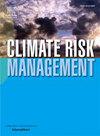跟踪医院的气候适应情况:结构性措施清单
IF 4.8
2区 环境科学与生态学
Q1 ENVIRONMENTAL SCIENCES
引用次数: 0
摘要
适应气候变化在降低气候变化风险方面发挥着至关重要的作用,国家政策也日益认识到适应气候变化的必要性。然而,在部门层面采取一致行动的证据各不相同,而且往往缺乏。本文对卫生部门采取的气候适应行动进行了批判性研究。其中包括收集和分析从学术和灰色文献中检索到的医院案例清单数据。在这一过程中,我们发现有关此类干预措施的报告非常少,而在更广泛的可持续发展或气候行动报告中,这些干预措施还没有被很好地涵盖。我们发现了 125 个已实施的结构性措施实例,这些措施旨在调整医院设施,使其更有利于应对预期的气候变化。通过这份清单,我们可以深入了解世界各地区所报告的适应行动及其背后的动机,这为我们考虑如何为这些投资进行商业论证提供了基础。首先,我们对初始数据的分析凸显了新的趋势,例如,经历过之前的天气事件或遵守现行建筑法规是进行适应的两个主要动机因素。其次,确定收集和汇编适应数据所涉及的挑战对气候适应领域本身以及推动决策和更好地了解正在发生的事情所需的数据都有影响。值得注意的是,从不同地区收集的证据包含数据可检索性方面的偏差,而北美的例子最容易获得。最后,预计该清单将为部门干预措施的分类提供一个基线,对理解适应实践的构成具有重要价值,对医院从业人员和研究人员都有裨益。本文章由计算机程序翻译,如有差异,请以英文原文为准。
Tracking climate adaptation in hospitals: An inventory of structural measures
Adaptation plays a critical role in reducing risks from climate change and the need for climate adaptation is increasingly being recognised in national policies. However, evidence of coherent action at sector level is varied and often lacking. This paper critically examines climate adaptation action taken in the health sector. This involved collecting and analysing data for an inventory of hospital-based cases, retrieved from scholarly and grey literature. This process highlighted a paucity of reporting on such interventions, which are not yet well-covered in wider efforts for sustainability or climate action reporting. We found 125 examples of implemented structural measures intended to adapt hospital facilities to respond more favourably to anticipated changes in climate. The inventory provides insight into what adaptation actions are being reported across regions around the world and the motivations behind them, which provides a basis for considering how business cases are being made for these investments.
Doing so means we are able to make three contributions to the field of climate adaptation. First, our analysis of the initial data highlights nascent trends, for example, experience of a previous weather event or adherence to current building codes are the two dominant motivating factors for pursuing adaptation. Second, identifying the challenges involved in gathering and compiling adaptation data has implications for the field of climate adaptation itself, and the data needed to drive decision making and better understanding of what is happening. Notably, the evidence collected from various regions contain biases attributed to data retrievability, where North American examples are most readily available. Finally, it is anticipated that the inventory—which provides a baseline for categorising interventions in the sector—has value for generating understanding of what comprises adaptation practice, beneficial to both hospital practitioners and researchers alike.
求助全文
通过发布文献求助,成功后即可免费获取论文全文。
去求助
来源期刊

Climate Risk Management
Earth and Planetary Sciences-Atmospheric Science
CiteScore
8.20
自引率
4.50%
发文量
76
审稿时长
30 weeks
期刊介绍:
Climate Risk Management publishes original scientific contributions, state-of-the-art reviews and reports of practical experience on the use of knowledge and information regarding the consequences of climate variability and climate change in decision and policy making on climate change responses from the near- to long-term.
The concept of climate risk management refers to activities and methods that are used by individuals, organizations, and institutions to facilitate climate-resilient decision-making. Its objective is to promote sustainable development by maximizing the beneficial impacts of climate change responses and minimizing negative impacts across the full spectrum of geographies and sectors that are potentially affected by the changing climate.
 求助内容:
求助内容: 应助结果提醒方式:
应助结果提醒方式:


